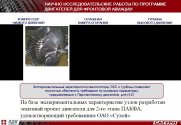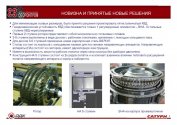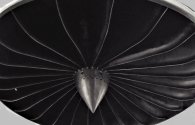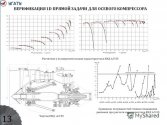There are just too many unknowns about what will be in the WS-15. I remember reports of work on SiC (?) ball bearings for engines in China at least a decade ago. So the engine could use much more advanced technologies to make the hot sections more heat resistant than we assume.
You are using an out of date browser. It may not display this or other websites correctly.
You should upgrade or use an alternative browser.
You should upgrade or use an alternative browser.
Chinese Engine Development
- Thread starter jackbh
- Start date
SiC ball bearings is pretty basic stuff, but even if they’re using those kinds of materials more extensively in more complex parts the level of technology isn’t just a function of how hot or fast you can run the engine. You’re not going to extract the maximum potential from more advanced parts and materials if you don’t use those advances to enable more advanced design of the gas flow dynamics. Because of how interdependently a gas turbine cycle works once a design is locked there’s only so much more you can do to improve it. No amount of using materials for the F-119 will turn an F-100 into an F-119 class engine, for example. I think we’ve heard rumors a year or two back that a revised iteration of the WS-15 is already in the works, and they’ll probably be able to squeeze out some impressive performance gains from that, but ultimately insofar as the design itself goes there’s going to be an upper bound to how much you can improve, and more advanced designs are going to tend to have higher upper bounds.There are just too many unknowns about what will be in the WS-15. I remember reports of work on SiC (?) ball bearings for engines in China at least a decade ago. So the engine could use much more advanced technologies to make the hot sections more heat resistant than we assume
Hendrik_2000
Lieutenant General
Seem like China realized the urgency to develop civilian Turbofan engine since access to western engine is not guarantee anymore. The old barter of market access to technology does not valid anymore. China is single out for restriction because everybody is scare of fierce competition since Aviation is one of the few technology field that china is behind
China faces urgent ‘unprecedented challenge’ to develop jet engine as foreign hostility grows
Published: 4:17pm, 17 Dec, 2020
Updated: 10:25pm, 17 Dec, 2020
Workers assemble part of the engine for China's C919 passenger aircraft at a factory of Shenyang Aircraft Corporation in Shenyang, Liaoning province. Photo: Reuters
China must be able to produce its own jet engine for commercial use as the world’s second biggest economy can no longer “leverage market access in exchange for technology” due to increasing foreign hostility, a senior engineer from state-owned Aviation Industry Corporation of China (Avic) says.
Liu Daxiang, deputy director of the science and technology committee at Avic, said aviation technology had accelerated this century and competition was getting “more fierce”.
The established countries in aviation have become more strict with us when it comes to technology access,” he said in a video seminar organised by the Chinese Society of Aeronautics and Astronautics.
“Recently we have seen the US utilising national power to suppress
, and this tells us that crucial technology cannot be bought, even if you spend big.
This is a serious and urgent political task, this is the unprecedented challenge that we are now facing Liu Daxiang
“In the past, we have leveraged market access in exchange for technology – I don’t think it works [for aviation].”
The aero engine expert, who was a former member of the Standing Committee of the National People’s Congress, said China needed to stop “fantasising” about acquiring the technology for engine manufacturing and focus on self-reliance, adding import costs were high and supplies “unreliable”.
“This is a serious and urgent political task, this is the unprecedented challenge that we are now facing,” he added.
Liu’s comments, which were published on Monday, follow a Reuters’ report last month that said the US Department of Commerce had drafted a list of 89 Chinese and 28 Russian companies, including Avic and 10 related entities, that were considered “military end users”
China faces urgent ‘unprecedented challenge’ to develop jet engine as foreign hostility grows
- A senior Chinese aviation engineer says it is an ‘urgent political task’ for China to speed up development of its own jet engine
- Access to crucial technology is no longer guaranteed due to external hostilities and China must become more self reliant
Published: 4:17pm, 17 Dec, 2020
Updated: 10:25pm, 17 Dec, 2020
Workers assemble part of the engine for China's C919 passenger aircraft at a factory of Shenyang Aircraft Corporation in Shenyang, Liaoning province. Photo: Reuters
China must be able to produce its own jet engine for commercial use as the world’s second biggest economy can no longer “leverage market access in exchange for technology” due to increasing foreign hostility, a senior engineer from state-owned Aviation Industry Corporation of China (Avic) says.
Liu Daxiang, deputy director of the science and technology committee at Avic, said aviation technology had accelerated this century and competition was getting “more fierce”.
The established countries in aviation have become more strict with us when it comes to technology access,” he said in a video seminar organised by the Chinese Society of Aeronautics and Astronautics.
“Recently we have seen the US utilising national power to suppress
, and this tells us that crucial technology cannot be bought, even if you spend big.
This is a serious and urgent political task, this is the unprecedented challenge that we are now facing Liu Daxiang
“In the past, we have leveraged market access in exchange for technology – I don’t think it works [for aviation].”
The aero engine expert, who was a former member of the Standing Committee of the National People’s Congress, said China needed to stop “fantasising” about acquiring the technology for engine manufacturing and focus on self-reliance, adding import costs were high and supplies “unreliable”.
“This is a serious and urgent political task, this is the unprecedented challenge that we are now facing,” he added.
Liu’s comments, which were published on Monday, follow a Reuters’ report last month that said the US Department of Commerce had drafted a list of 89 Chinese and 28 Russian companies, including Avic and 10 related entities, that were considered “military end users”
Last edited:
Yes, that US list includes the parent company of Irkut which makes the MC-21.
So, they had already banned them from purchasing composites from the US or Japan. Now they are banning them outright. There were rumors on Russian press that Irkut the manufacturer had said their Western suppliers were warning them for months they couldn't deliver on contracts despite not having sanctions on those products yet at the time. It seems this is why.
Good thing Russia already has flying prototype with PD-14 engine. Plus it has already manufactured its own composites and made them into a wing that has been successfully tested on the lab. They have also recently been able to manufacture APUs in Russia and the Russian avionics are expected to be finished in 2 years time.
This also sticks a fork into the eye of those who thought Putin's insistence on having native Russian components on civil aircraft was 'anti-market' as it is plainly obvious now that the clampdown has come that without having native supply chain the choice is having no product at all and remaining a colony which sells mined resources to the colonizer while importing manufactured goods.
Russia also plans to make the Sukhoi Superjet 100% native with PD-8 engine.
The Boeing-Airbus duopoly does not allow any competition.
China better step up their game.
So, they had already banned them from purchasing composites from the US or Japan. Now they are banning them outright. There were rumors on Russian press that Irkut the manufacturer had said their Western suppliers were warning them for months they couldn't deliver on contracts despite not having sanctions on those products yet at the time. It seems this is why.
Good thing Russia already has flying prototype with PD-14 engine. Plus it has already manufactured its own composites and made them into a wing that has been successfully tested on the lab. They have also recently been able to manufacture APUs in Russia and the Russian avionics are expected to be finished in 2 years time.
This also sticks a fork into the eye of those who thought Putin's insistence on having native Russian components on civil aircraft was 'anti-market' as it is plainly obvious now that the clampdown has come that without having native supply chain the choice is having no product at all and remaining a colony which sells mined resources to the colonizer while importing manufactured goods.
Russia also plans to make the Sukhoi Superjet 100% native with PD-8 engine.
The Boeing-Airbus duopoly does not allow any competition.
China better step up their game.
Last edited:
Hendrik_2000
Lieutenant General
Here is the latest of WS 15
Fu Qianshao: The chief designer was selected into the list of military industry figures. Has Turbofan-15 really been a big success? . Maybe some one will give summary
Fu Qianshao: The chief designer was selected into the list of military industry figures. Has Turbofan-15 really been a big success? . Maybe some one will give summary
Here is the latest of WS 15
Fu Qianshao: The chief designer was selected into the list of military industry figures. Has Turbofan-15 really been a big success? . Maybe some one will give summary
I wouldn’t read too much into it. The so called award was a web award created by some website and anyone in China could vote on them.
Documentary on WS-10 and WZ-9.
Last edited:
What you and everybody else found about WS-15 is not spec from any official or designer's source, the "likely specs of Izd.30" means it is not official either. This simply means that nobody knows, all being talked about are perhaps and maybes.I don't mean to defend this article, which is thin on facts and gratuitously harsh, but a response in the same tendentious vein is unhelpful.
Where's the evidence? It's possible to assemble a pretty good picture of what Izd.30 is probably going to be like by know, and it's quite impressive. What is there that would suggest WS-15 is better? What little info I've found over the years was pretty unreliable and even taken at face value did not match the likely specs of Izd.30. And there is more to an engine like the Izd.117S than sheer thrust - when the up-rated WS-10 versions first appeared, the TBO and life figures bandied about were about half of what the 117S provides. That's no minor difference, considering their claimed turbine inlet temperatures are virtually identical (so the Russians aren't running it deliberately cool to conserve life).
And at any rate, Izd.117S has been in series production for almost 10 years by now - it's hardly representative of the bleeding edge in Russian engine technology any longer.
I think it is better that we say "we know nothing" than speculation about any of the engines.
What you and everybody else found about WS-15 is not spec from any official or designer's source, the "likely specs of Izd.30" means it is not official either. This simply means that nobody knows, all being talked about are perhaps and maybes.
I think it is better that we say "we know nothing" than speculation about any of the engines.
For Izd. 30 there are in fact some comments in the public domain from the General Designer of NPO Saturn. And leaked official documents are most certainly official sources (they might even be more accurate than sanitized officially approved releases)! Finally, even if you don't know a certain specification exactly, narrowing it down to a sufficiently small range will often do for comparison with competing engines.
I realize (and stated as much) that virtually nothing is known about the WS-15 at all. My point was merely that if we for argument's sake assume what speculation there is (which would likely tend to be optimistic) as true, it would not work out to an especially advanced engine.
However, to portray the available information on Izd. 30 as equally meagre is definitely a misrepresentation! As I said, the data is scattered around numerous sources in small, disjointed pieces, but that doesn't mean it isn't reliable. Since virtually nothing of it comes from the usual Western publications, finding it takes some experience and assembling it all into a coherent picture requires a modicum of turbomachinery knowledge. But providing that, remarkably detailed information on its architecture and some cycle parameters can be deduced. At the risk of straying too far off-topic I'll give an overview below, mods feel free to move it to the Su-57 thread or delete.


Above are two official slides from 2013 which were leaked - the partially censored one shows the 3-stage fan/LPC blisk and its text ties the document to the PAK-FA 2nd-stage engine (i.e. Izd. 30). The second gives a detailed description of the 5-stage HPC, an interesting item being that the first-stage inlet guide vanes are the only set of variable stators on the entire module. Single-stage turbines are pretty much a given (the F135 only has a 2-stage LPT for commonality with the STOVL variant), so this tells us Izd. 30 is very EJ200ish in architecture: 3LPC+5HPC+1HPT+1LPT with lots of compressor blisks and only one variable vane row in the HPC. The latter indicates advanced compressor aerodynamics to ensure fast throttle response for the fighter mission without VSVs and handling bleeds.
Unlike the EJ200 however, we know Izd. 30 has a pretty funky fan IGV, shown on the next image which was leaked on a Russian aviation forum in late-2017 (there were a two more, but this'll do). Considering the straight nature of the Su-57 intake ducts, it's possible that these also act as a RF line-of-sight blocker, but that's basically conjecture. We do know the interim Izd. 117 engine at least has a different solution.

Thermodynamic cycle parameters? This requires you to exercise a certain amount of judgement, but it's possible to fairly confidently assert the LPC will have a pressure ratio of 4.2+ (matching or exceeding the EJ200), and that the HPC will reach roughly 6.5 to 7.0 (compared to 6.2 for the EJ200). OPR would therefore be somewhere between 28 to 30, roughly the same as the F414 but with 2 fewer stages and beating the EJ200, i.e. a higher stage pressure ratio than both. Turbine inlet temperature ought to be anywhere between 1850 and 2100K. How do I figure all that?
A reasonable lower bound on LPC pressure ratio can be established from a compressor map for the LPC of the AL-55 trainer engine which is also 3-stage blisk design, also by NPO Saturn:
 ("UGATU" is the Ufa State Aviation Technical University, in case you were wondering)
("UGATU" is the Ufa State Aviation Technical University, in case you were wondering)It reaches almost 4.2, so a much larger compressor designed with later technology by the same company should exceed that ratio (due to relatively smaller blade tip clearance and hence lower tip leakage loss). Assuming Izd. 30 is a 18tf engine, the scale factor in mass flow and area from the AL-55 is an order of magnitude (!), whereas the EJ200 is "only" a factor of <2.0, still close enough to be roughly in the same ball park.
For the HPC, I base my estimate on the stage pressure ratio achieved by the 8-stage PD-14 HPC at a quoted PR of 17.0. Shorter compressors achieve better stage-PRs because ideally each stage would rotate at its own optimum speed, so on a long compressor the fixed rpm makes it hard to match the front and rear stages. As a result, the 11-stage GE9X HPC with its 27.0 pressure ratio achieves a stage-PR of 1.349 while its *older* siblings on the GEnx (10 stages, 23.0) and GE90-115B (9 stages, 19.0) reach 1.368 and 1.387, respectively. Based on this _very_ rough reckoning, a 5-stage compressor derived from PD-14 technology might hit 6.5 to 7.0. As noted earlier, this is better than the EJ200, but that's credible - the PD-14 HP compressor also beats its closest Western counterpart, the 8-stage HPC of the PW1100G (16.0).
Possible corroboration of this comes from NPO Saturn's competitor Salyut, curiously enough. They lost out in the face-off to win project leadership of what would become Izd. 30, but when the engine first flew in late-2017 they released some interesting information:
It states HPC PR is 6.7, mass flow 21-23kg/s (almost certainly reduced/corrected flow, absolute core mf on a 18tf fighter engine would be on the order of 100kg/s) and turbine inlet temperature 1950-2100K. This should be taken with a grain of salt, because although Salyut was originally supposed to contribute certain parts of the Izd. 30, their current association with the project is questionable. One area of their responsibility was to be a PYBBN-style 3D TVC nozzle, but the flight test engine was fitted with a low-observable version of the Saturn 2.5D ball joint design. In any case, the HPC was NOT their purview and the quoted mass flow (even taken as corrected/reduced mf) seems too low for a 18tf engine but fits their AL-31FM2/3 semi-5th generation engines well. That would also mean these figures refer to a 6-stage compressor, but as Saturn won the competition similar performance from their 5-stage design isn't implausible.
Same goes for the turbine inlet temperatures, the absolute lower bound for which would be the 1850K figure from the PD-14 that is aimed at much higher durability and longer TBO. As an aside, the Izd. 20 VCE designed in the late-1980s/early-1990s aimed for a turbine inlet temperature of 1900K (50-100K higher than its Western contemporaries!), an ambition which may well have contributed to its failure.
Finally, VCE or not VCE? In this respect I turn to the interview with the Saturn General Designer mentioned above, though sadly his statements are not entirely clear-cut:
Relevant quotes:
Yevgeniy Marchukov said:The generational change occurs with the simultaneous improvement of all these characteristics. In this regard, “Product 30” can even be attributed to the “5+” generation, since this engine was created taking into account domestic and foreign experience in the development and operation of fifth generation engines. In the USSR, and then in Russia, such an engine was “Product 20”. It was planned to install it on the MiG-1.44 MFI fighter [...] ”said [...] Marchukov.
Yevgeniy Marchukov said:“Compared to engines of the fourth generation, the fifth has added the ability to cruise supersonic motion - for this, the engine must have a variable bypass ratio. This requirement has added one more specific parameter - specific fuel consumption at cruising supersonic [...]”Marchukov said about the new power plants.
Make of that what you will, he speaks in very general terms about VCEs, without confirming outright that his comments apply to the Izd. 30. Certain Big-Shrimpskis (
Last edited:
Anyone know what the difference between ACAE CJ-1000A and WS-20.. Why China not master turbofan engine for civilian plane yet..even Russia already use Pd-14 engine for their plane MC-21.. c919 still use Leap engine manufactured by GE..now Comac already get sanctioned.. So the alternative is by using pd-14 engine for mass production of c919 since china engine is still unproven.. but i dont think russian will share their turbofan engine technology to china..
